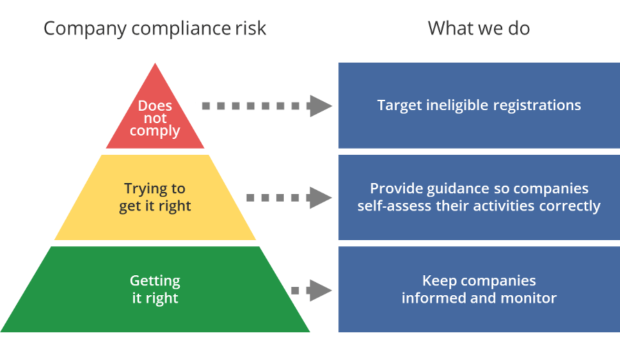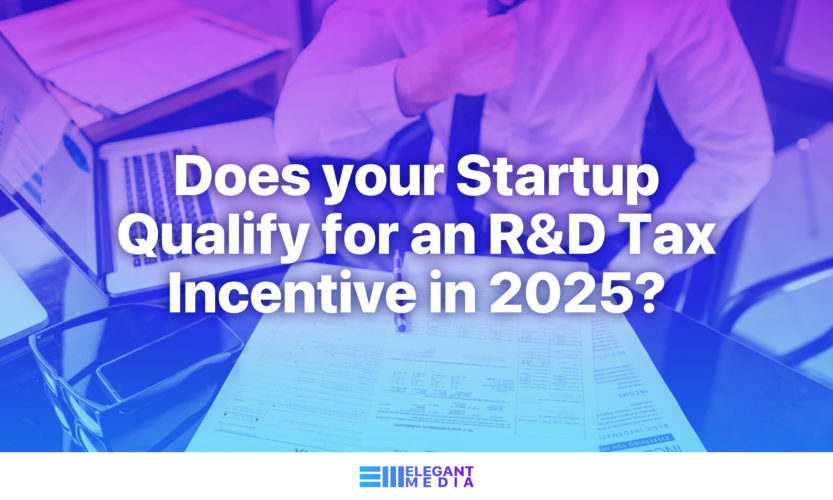The R&D Tax Incentive is an Australian Government-backed Incentive Scheme that aims to Drive and Encourage R&D Activities by providing a tax offset.
The R&D Tax Incentive or Research and Development (R&D) Tax Incentive, is jointly administered by ‘AusIndustry’ on behalf of Industry, Innovation and Science Australia and the Australian Tax Office (ATO).
This Scheme also nudges companies to undertake R&D that may not be possible due to immediate concerns about future returns. The R&D Tax Incentive is therefore somewhat of a safety net providing Companies with the opportunity to proceed with R&D bearing a sense of security and optimism.
If you are an aspiring Startup, in this article we ask Does your Startup Qualify for an R&D Tax Incentive?
- Who Can Qualify?
- What are Core R&D activities?
- 4 Important Steps
- Eligible R&D Expenditure
- Do I have to Spend a Minimum Amount on R&D?
- Can I Only Claim for R&D Activities?
- Tax Offset Benefits
- Does my Startup Idea need R&D?
- So What Kind of Startup Idea Can Succeed?
- Is aiming for an R&D Tax Incentive Worth It?
- R&D Tax incentive Checklist!
- Conclusion
Who Can Qualify for R&D Tax Incentive?
Eligible Entities
If you are a corporation registered under Australian Law then you are eligible.
Eligible Activities
The R&D Tax Incentive is focussed on supporting ‘Core R&D Activities’ taking place within a fixed time period of a financial year.
What are Core R&D Activities?
“In order to be eligible, there must be an experiment or experiments being carried out, for the purpose of generating new knowledge. The outcome of the experiments, cannot be able to be known or determined in advance by a competent professional in the field. Supporting activities may also be eligible if they are directly related to eligible experimental activities.”
Research and Development Tax Incentive
4 Important Steps
1: Self-assess your Eligibility
2: Conduct R&D activities keep records
3: Register for the R&D Tax incentive Scheme
4: Claim your Tax Offset
Eligible R&D Expenditure
Before you go about claiming any R&D Tax Incentives, you must first register your R&D activities. This is because only registered R&D activities are eligible for any Tax Offset Claims.
It is important to note that as a Startup, it is upto you to figure out by self-assessment, if your R&D activities are eligible for R&D Tax Incentives and then approach the ATO.
“It’s your responsibility to ensure that your registration and claim for the R&D Tax Incentive are correct.”
Research and Development Tax Incentive
Do I have to Spend a Minimum Amount on R&D?
- YES!
- To be eligible for any R&D Tax Incentives, your R&D expenditure (notional deductions) for a financial year, must be at least AU$20,000.
- This may seem like a significant amount of money but remember to always think big!
- If your investment in R&D can lead to your Startup Idea becoming a commercial and profitable venture, then through this scheme you can expect to receive a substantial portion of your R&D spend back.
What if my R&D Activities are less than AU$20,000?
- If your R&D Activities are less than AU$20,000 then you may still qualify however, you would have to work with a registered Research Service Provider (RSP). A list of Accredited Research Service Providers for each industry/sector is maintained by ATO.
Can I Only Claim for R&D Activities?
- Yes as your proposed R&D Activity must be first registered before being eligible to make a claim for any Tax Offset Claims.
- It is also mandatory to maintain records to support your claims that highlight how your R&D expenditure was disbursed.
- You cannot make Tax Offset Claims for certain excluded activities, that include market research, development, testing, sales promotions or consumer surveys.
- Most importantly your R&D Activities must not be utilized to develop solutions for internal administration.
- Applicants cannot make claims for ordinary business activities under any circumstances, so be aware if your expenditure falls under the interpretation of the ATO. You can read more about interpretations of activities here.

R&D Tax Incentive – Tax Offset Benefits
- For applicants claiming tax offset benefits for eligible R&D undertaken up to 30 June 2021, the R&D Tax Incentive provides either a tax offset of 43.5% for companies with an Annual Turnover of less than AU$20 million and 38.5% for companies with an Annual Turnover of more than AU$20 million.
- From July 1, 2021 if you have an Aggregated Turnover of less than AU$20 million, the tax offset benefit is your Corporate Tax Rate plus an 18.5% premium.
- For those entities with Aggregated Turnover of AU$20 million or more, the tax offset benefit is your Corporate Tax Rate plus an incremental premium.
- The increment of the premiums are based on your R&D Intensity. This can be defined as a percentage of your eligible R&D Expenditure as a proportion of your total expenditure for the year.
Does my Startup Idea need R&D?
- Yes! Research and Development is very much part of the Startup Product Development Process.
- If you have a breakthrough Startup Idea that requires core Research and Development to further develop technologies, processes or systems, then your expenditure can result in a Tax Offset Claim.
- Research and Development projects consist of a series of steps and it is these steps that we can class as R&D activities.
- Each R&D activity will generally require one or more actions that you must complete to achieve an outcome.
- The R&D Tax Incentives support R&D activities that can be shown to follow a set of specific actions. These actions must meet the requirements set out in the definition of an eligible R&D activity.
So What Kind of Startup Idea Can Succeed?
- Startup Ideas that revolve around Agriculture, Biotechnology, Energy, Manufacturing, Mining, Software Development and The Built Environment, have all had success stories with R&D Tax Incentives.
- In order to better understand the present, we must look into the future. If your Startup Idea promises to revolutionise the future in the form of new or improved materials, products, devices, processes or services, then you are definitely on the right path to availing R&D Tax Incentives.
- For Mobile App related startups, if your Mobile App Idea presents a new way of doing things across the domains of Machine Learning or Artificial Intelligence. Then this will no doubt need several stages of Core Research and Development Activities and therefore could well be eligible for an R&D Tax Incentive.
- It would be good to point out that your vision must be ambitious and your startup Idea, revolutionary in pivoting the future of a particular sector or industry along with new technology, in a significant manner.
- If you are a Startup then you are most likely to have an aggregated turnover of less than AU$20 million.
- By working with ATO Accredited Research Service Providers you can collaborate with others that share your area of research and create jobs locally, a key expected benefit of the R&D Tax Incentive.
Is Aiming for an R&D Tax Incentive Worth It?
- Definitely!
- If your Startup Idea requires Research and Development Activities that are based on ‘principles of established science and proceeds from hypothesis to experiment, observation and evaluation, and leads to logical conclusions’, then you can stand to benefit in the long term with a tax offset benefit.
- Always Remember You must conduct the above-mentioned activities for the purpose of generating new knowledge, in the form of new or improved materials, products, devices, processes or services.
- If you do not register your R&D activities clearly and precisely and follow up on the agreed scope of those activities your R&D expenditure may not be eligible for this Research and Development Tax Incentive.
R&D Tax Incentive Checklist!

- Are you a Registered Australian Business?
- Does your Business Idea require Research and Development?
- Will your R&D Activities lead to new or improved materials, products, devices, processes or services?
- Then you may be eligible to receive a R&D Tax Incentive
Conclusion
R&D Tax Incentive or Research and Development Tax Incentives aim to stimulate innovation, collaboration and job creation. Research and Development activities benefit business stakeholders, communities and the broader Australian economy alongside providing the opportunity for creating new knowledge, technology and processes, that helps Australian business to succeed.






